Lately, we’ve heard from some of our Grant Writing Made Easy students about their experiences giving presentations as part of the process for some grant competitions. Their success stories have been so inspiring to us, and they got us thinking about what makes a good presentation.
There are quite a few instances where you might be required to give a presentation to a grantmaker, including grant competitions, site visits, and other meetings with grantmakers.
These presentations are generally an opportunity for a nonprofit to share more information about their program and organization that they might not have had space to include in the proposal itself as well as providing that information in a more visual way.
Today, we want to share some of our best strategies for giving presentations, so that when the time comes, you can have the same kind of successes that our students have had recently.
Here’s what you’ll learn to do:
- Understand grantmaker expectations for the presentation
- Make a timeline and plan for the presentation
- Define your goals for the presentation
- Create an effective PowerPoint slide show
- Speak with ease
Understand grantmaker expectations for the presentation
Have you ever found yourself stumbling over a question you didn’t expect to have to answer in an interview? Or maybe you know what it feels like to talk about a topic that just came right out of the blue in a casual conversation. These can be seriously stressful situations.
It never feels good to be caught unaware, especially when the focus is on you.
One of the best ways to avoid feeling this way when you give a presentation is to do your research on what the expectations are for the presentation.
For example, can you expect a question and answer period? How many people will be in the room? Are you expected to have a visual aid, like a PowerPoint presentation? How long are you expected to speak? Is it advisable for you to have another person from your organization give the presentation with you or is it more of a solo thing?
These are some of the questions you will want to know the answers to long before you walk into the room to give a presentation. In fact, the answers to these questions will be important as you prepare for the presentation.
So, if you don’t know the answer these questions, make sure you get in touch with the grantmaker for clarification. You’ll also likely receive some bonus points with them for knowing to ask and for being engaged in the process.
Make a timeline and plan for the presentation
Once you have an idea of what the grantmaker is expecting from your presentation and when the presentation will occur, you can start planning the work leading up to the big day.
A lot of this is going to be very specific to each nonprofit’s situation and the expectations of the grantmaker, but I want to offer some advice on how to go about the presentation planning process.
First of all, it is important to set a timeline for the planning process. Work backwards from the date that you will be giving the presentation.
A few days before that date, plan to give a practice version of the presentation to others in your organization. Ask them for their feedback on the delivery and content of the presentation.
Before giving the practice presentation to your colleagues, you’ll want to have a plan for what to say and the visual aid developed. What we recommend when planning (or blocking out) what you’ll say in the speech is to first write a word for word version of what you want to say.
After you have the full text, then condense that down further into a shorter outline, with just a few key phrases. This is the version that you want to memorize.
Sometimes, people try to memorize word-for-word what they plan to say, but that usually makes the speech come out stilted and robotic. When you memorize the key phrases outline, you’ll be better able to extemporize and sound natural when you give the presentation.
If you have enough time, plan to spend a week or two working on this part of the planning process. I really cannot overstate how important it is to spend enough time on a writing project. Coming back to a draft with fresh eyes after a few days of being away from it is one of the best ways to catch awkward and unclear writing.
While working on the plan for what you’ll say, design your PowerPoint slideshow or other visual aid, if that is appropriate for the circumstances. I’m going to share some more advice below on how to design successful slideshows.
As you make a plan for developing your presentation, write down each of the steps and the dates by which you want to accomplish them. Share this schedule with a few other people in your organization, so that they can help keep you accountable!
Define your goals for the presentation
Like I said above, the goals of each presentation will vary from nonprofit to nonprofit and from grantmaker to grantmaker.
But generally, they will fall into one of two categories: presentations that seek to convince the grantmaker to fund your work and presentations that report on the successes of a program the grantmaker is already funding.
Essentially, the point of both of these types of presentation is the same. You’re trying to persuade the grantmaker that the work you do is worthy of their interest, time, and funding, but they will vary in the amount of detail you need to provide.
So that’s the first question that you have to ask when defining the goals of the presentation—how much detail do I need to include?
If you’re giving the first type of presentation, another question to ask yourself as you define the goals of your presentation is how much time you want to devote to a couple of important sections, including the need, your past successes (or organizational history), and the program design.
If you have already submitted a proposal to the grantmaker and the presentation is an opportunity for them to learn more about your program and organization, make sure to include information in the presentation that you feel needs to be further explained.
If you’re giving the second type of presentation, which is essentially part of the grant reporting process, you will want to ask yourself how you can best convey the results of your program. I recommend using a blend of quotes and statistics.
You can get a little more creative if you have the time and resources and include a short video testimonial from a program participant in the presentation to encourage a powerful emotional connection between the audience and your program. Of course, you’ll have to get permission to film and share such a video.
Create an effective PowerPoint slide show
We have all seen ineffective PowerPoints. You know the ones with the walls of text? And the strange font choices? Yeah, those are examples of what not to do.
And even though it’s usually easy to identify an ineffective PowerPoint, it is much more challenging to articulate what makes a successful slideshow.
One of the most important qualities of a good PowerPoint is that it is not distracting. You are the one giving the presentation, so don’t let the slideshow hog the audience’s attention. To keep the presentation working as an aid and not as a distraction, you can make use of the animations tool.
I encourage you not to get too fancy with these. Usually, a simple “appear” animation will do the job. Making the text appear as you talk about each point will keep your audience from reading ahead of you and not focusing on what you are saying.
Another key to creating a strong PowerPoint presentation is to use images on the slides. If you have photographs from your program, include these when you describe the program design. (Again, make sure that you have consent from anyone pictured before sharing them in a presentation.)
When describing the need, you will want to share some statistics about the demographic you serve. But, you surely don’t want to put a long list of numbers on the slide, or worse yet, read them to your audience.
In this case, you can create a small graph or chart that will quickly communicate the gist of the numbers.
My final piece of advice on designing effective PowerPoints is to make it look polished and professional. Pick a readable font and make sure it is large enough that people sitting far away can still read it.
Use the templates PowerPoint provides to make the slideshow more visually interesting.
(Pro tip: turn on PowerPoint design insights. They sometimes have great ideas for how to make your slides more appealing.)
Speak with ease
So far, I’ve shared a lot of advice on what to do leading up to the day of your presentation, including how to plan for it, how to define the goals of the presentation, and how to make a strong visual. What’s missing from this discussion? The delivery of the presentation itself, of course!
I’m not going to bore you with tips on how to dress for the presentation or how to keep from saying “ummmm” because I am sure you have all this down. Instead, I want to get a little more sophisticated with my advice.
Like I mentioned above, you will not want to sound stilted and robotic when you give the presentation. One way to sound more conversational and natural is to give yourself an opportunity to laugh in the presentation.
Sometimes, this might not be appropriate, but if the room seems warm enough, don’t be afraid to loosen up, too. For example, if you drop the slide clicker, instead of appearing flustered, laugh it off.
Or, save some time to tell an emotional story about one of your program participants and don’t be afraid to share how much it matters to you.
Another strategy for sounding conversational is to take a break for questions in the middle of the presentation.
Even though most presentations save questions for the absolute end, there is no rule against pausing for a quick question part of the way through.
Of course, you won’t want to get too sidetracked, so don’t take a five-minute break in the middle of a fifteen-minute presentation.
When answering questions, respond using the name of the person asking, if you know it. This will make the audience feel a stronger personal connection to you.
There is a lot that goes into giving a great presentation, but it does not have to be as intimidating as it sometimes seems.
One of the best ways to avoid feeling those presentation jitters is to practice giving the presentation to people you’re comfortable with before you present to the real audience. Practice a few times, if you need, until you feel comfortable enough with the content that you don’t have to peek over your shoulder to remember what comes next.
If you loved this article and want to learn more about how you can write proposals that get you in the room giving that presentation to a grantmaker, please check out our comprehensive online grant writing course, Grant Writing Made Easy.







